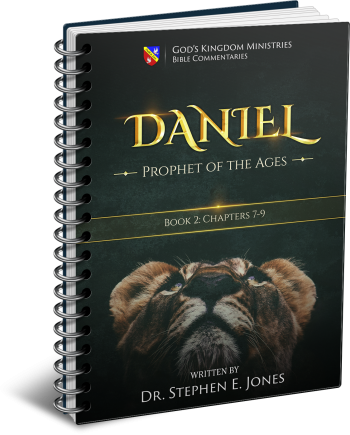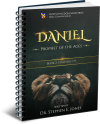Latest Posts
View the latest posts in an easy-to-read list format, with filtering options.

This is a commentary covering the first three of Daniel's visions in chapters 7-9.
Category - Bible Commentaries

When Daniel finished relating his vision to his audience, he then continued to tell the audience about his conversation with an angel. Daniel had many questions about the meaning of this vision. He wanted more details, particularly about the fourth beast and the little horn on its head.
From Daniel 2 we know that the prophet already knew that three more empires would arise after the fall of Babylon. These were revealed in terms of metallic parts on a statue. So the vision in chapter 7, showing four beasts, must have given him further revelation about the kingdoms that were yet to arise.
By the time Daniel received the vision in chapter 7, Persia was already rising, so it would not have been difficult for the prophet to foresee that it was to be the second beast. The third beast (Greece) would not rise for two more centuries, but he learned its identity in the third year of Belshazzar (Dan. 8:1, 21) a decade before Babylon’s fall.
Nonetheless, Daniel’s main interest was in the identity of the fourth beast. Rome was the farthest down the line, in terms of time and also in its distance from Babylon.
We read in Daniel 7:16,
16 I approached one of those who were standing by [“one of the risers,” CV] and began asking him the exact meaning of all this. So he told me and made known to me the interpretation of these things:
The Concordant Version calls him “one of the risers.” Daniel did not call him an angel, though we may use that term in a general sense. Who was this riser? Was he one of many? How did he rise?
It appears that this refers back to Dan. 7:10, where the CV says, “ten thousand ten thousands are rising before Him.” This pictures the resurrection, when multitudes rise up (from the dead) in honor of The Grayheaded One (Lev. 19:32) and are brought before Him at the Great White Throne. “One of the risers” apparently was close enough to the prophet (in his vision) to question about the meaning of these events.
It appears that John had a similar experience when receiving his visions in the book of Revelation, for we read in Rev. 19:10,
10 And I fell at his feet to worship him. And he said to me, “Do not do that; I am a fellow servant of yours and your brethren who hold the testimony of Jesus; worship God. For the testimony of Jesus is the spirit of prophecy.
On another occasion, Rev. 22:8 and 9 says,
8 And I, John, am one who heard and saw these things. And when I heard and saw, I fell down to worship at the feet of the angel who showed me these things. 9 And he said to me, “Do not do that; I am a fellow servant of yours and of your brethren the prophets and of those who heed the words of this book; worship God.”
Here we find that the “angel” was “of your brethren the prophets.” The Greek word for angel is aggelos (pronounced “angelos”). The Hebrew word is malak, “messenger.” A messenger can be either an earthly or heavenly being. In John’s case, the angel claimed to be one of the prophets. It hardly seems credible that this “angel” was a living prophet who was revealing this prophetic information to John on the island of Patmos. So who was he? We are almost forced to conclude that the angel was a prophet or “saint” who had lived in former times and had since died, only to be sent back to give John this revelation.
This takes us into other areas of study, particularly the state of the dead, the issue of time, and the fact that God “is not the God of the dead, but of the living; for all live to Him” (Luke 20:38). Abraham, Isaac, and Jacob were all dead insofar as man’s perspective is concerned, but from God’s timeless perspective, “all live to Him.” Hence, Moses and Elijah were able to appear on the Mount.
God stands above time. If we believe that in the end we will all escape the limitations of time and space, then it will be possible to re-enter the world at any point in time that we wish. Therefore, if we think of John’s “angel” as a past saint who will be raised later, it is conceivable that this angel-saint could return to earth (Patmos) at that point in time to give John this revelation.
Our minds are not trained to think outside of the earthly limits of time and space, but in no way does this prevent God from transcending those limitations. Neither is there any real reason to believe that such “angelic” visitations are unlawful or impossible, since we all will transcend time and space at some point in the future.
So it appears that both Daniel and John spoke with prophets and/or saints. John called his contact an “angel,” though he was but a “fellow servant,” while Daniel called him “one of the risers” (from the dead).
After Daniel asked the riser about “the exact meaning of all this,” Dan. 7:17, 18 says,
17 These great beasts, which are four in number, are four kings who will arise from the earth. 18 But the saints of the Highest One will receive the kingdom and possess the kingdom forever, for all ages to come.
From the divine perspective, the little horn was not a separate beast. There were only four great beasts, and the little horn was to be seen as an extension of the fourth beast. The NASB calls them “four kings,” but it is obvious that they are kingdoms, not individual kings, because each beast nation had more than one king during its time to rule. The CV renders it “four kingdoms.”
The short interpretation of the vision, then, is that four kingdoms will rule before they are replaced by the Kingdom of the Most High. The four are temporary; the last will endure “for all ages to come.”
Further, this is the first time that we are told that “the saints of the Highest One will receive the kingdom and possess the kingdom.” This new detail, given by the riser-angel, shows that the reign of Christ includes the saints. This, of course, is also part of the revelation given to John many years later in Rev. 5:10 and 20:6.
In Dan. 7:19-22 the prophet asked for more details regarding the fourth beast and its horns:
19 Then I desired to know the exact meaning of the fourth beast, which was different from all the others, exceedingly dreadful, with its teeth of iron and its claws of bronze, and which devoured, crushed, and trampled down the remainder with its feet, 20 and the meaning of the ten horns that were on its head, and the other horn which came up, and before which three of them fell, namely, that horn which had eyes and a mouth uttering great boasts, and which was larger in appearance than its associates.
This was a very long and detailed question that repeats what we were told earlier. But then it appears that Daniel “kept looking” and saw further details even before the angel answered his question.
21 I kept looking, and that horn was waging war with the saints and overpowering them 22 until the Ancient of Days [or Transferrer of Days] came, and judgment was passed in favor of the saints of the Highest One, and the time arrived when the saints took possession of the kingdom.
Daniel had seen the boasts of the little horn and had seen him uproot three of the other horns, but up until this moment he had said nothing about “war with the saints.” In this war the little horn was to overpower the saints “until the Ancient of Days came.” The turning point would come when “judgment was passed in favor of the saints.” This indicates a decision or verdict rendered by the divine court at the end of the time allotted to the final beast kingdom.
History shows that men—even believers—fought back against the oppression and persecution throughout the past centuries. But their success was limited by the previous divine court’s judgment upon Jerusalem, in which the four beasts were granted jurisdiction over that city and all others in that part of the world. In the end, the situation would not change until God’s 2,520-year contract with those beast nations had come to an end.
We believe that on Oct. 16, 2014, the eighth day of the feast of Tabernacles, the “judgment was passed in favor of the saints of the Most High.” The little horn’s time to rule then reached its final end on Dec. 30, 2014, which was the 1480th anniversary of Justinian’s establishment of Church law in 534 A.D.
The saints of the Most High now have the favor of the divine court and have received the Dominion Mandate to reign with Christ. From a legal perspective the long era of beast rule has ended. The problem is that the beast nations do not want to give up their power, so the saints must take it from them through spiritual warfare.
It was the same when God gave Israel the land of Canaan. The Canaanites did not agree with this ruling in the divine court, so Joshua was commissioned to take the land. Under the Old Covenant, this was done by military force. Today, under the New Covenant, we are given a much sharper sword—the sword of the Spirit, which is the word of God (Eph. 6:17). It is the word coming from our mouths, not from our hands (Rev. 19:15). It is the word of the Kingdom, which is accompanied by the power of the Holy Spirit. It is demonstrated not by how many enemies may be killed, but by how many hearts may be pierced with the truth until His glory fills the earth.
This is the time in which we now live.